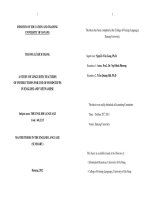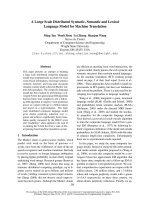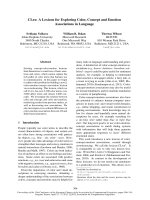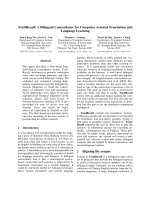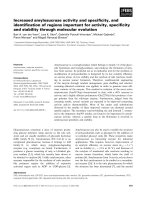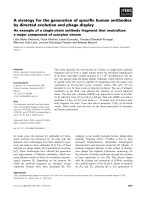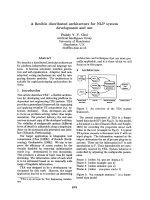visual language representation for use case evolution and traceability
Bạn đang xem bản rút gọn của tài liệu. Xem và tải ngay bản đầy đủ của tài liệu tại đây (657.14 KB, 147 trang )
VISUAL LANGUAGE REPRESENTATION FOR
USE CASE EVOLUTION AND TRACEABILITY
A Dissertation
Submitted to the Graduate Faculty of the
Louisiana State University and
Agricultural and Mechanical College
in partial fulfillment of the
Requirements for the degree of
Doctor of Philosophy
in
The Department of Computer Science
by
Coretta Willis Douglas
B.A., Mississippi State University, 1974
M.S., Louisiana State University, 1998
May 2008
ii
Acknowledgements
I am grateful to my parents, Mr. and Mrs. Elward S. Willis, who encouraged me to study
by their example and inspire me still with their curiosity to learn. To my friends at
Louisiana State University, Elias Khalaf, Guillermo Tonnsman, Steve O’Neal, and Nigel
Gwee who inspired me to continue my formal studies, I am grateful for their example too.
Dr. Kraft was especially persistent in his encouragement and support; it is particularly
because of him that I was motivated to undertake this challenge and have persisted. To my
friends and my family (especially my husband, Mel) whom I have often neglected because
of my academic pursuits and research endeavors, you have been so patient with me; thank
you. My committee, Dr. Doris Carver, Dr. Jianhua Chen, Dr. Donald H. Kraft and Dr. Ye-
Sho Chen, has been ever-supportive by guiding me, applying a needed push to get me back
on track, and commending me on my efforts just when I needed it most. I have been most
fortunate to have Dr. Carver as my major professor. She is a patient teacher with a gentle
character; she astounds me with her knowledge of the field and her thorough and
consistent analysis of our research. I have learned greatly under her tutorage having been
more challenged by her well-spoken challenging questions than in many lectures. She
propels me to study, to improve and to progress. Thank you, especially Dr. Carver, and all
who have upheld me on this journey.
iii
Table of Contents
Acknowledgements ………………………………………………………………… ii
List of Tables ………………………………………………………………………… v
List of Figures ……………………………………………………………………… vi
Abstract ………………………………………………………………………………. viii
1. Description of the Problem ………………………………………………………
1.1 Domain Modeling …………………………………………………………
1.2 Motivation ………………………………………………………………
1.3 Summary ………………………………………………………………….
1
2
3
6
2. Modeling with UML ……………………………………………………………….
2.1 Requirements Engineering ………………………………………………
2.2 Overview of UML … ……………………………………….…………
2.2.1 The Use Case View ……………………………………………
2.2.2 The Logical View ……………………………………………….
2.2.3 The Ontological Specification ………………………………….
2.3 Use Case Evolution ……………………………………………………….
2.3.1 Hierarchical Structure of Use Cases ……………………………
2.3.2 The ATM Banking Example ………………………………… …
2.3.3 Use Case Extension and Inclusion ……………………………
2.4 Summary………………………………………………………………….
8
8
9
10
13
15
16
17
18
19
22
3. Related Research …………………………………………………………………
3.1 An Incremental Method for Specification ………………………………
3.2 Graphical Representations of Requirement’s Behavior …………………
3.3 Lightweight Behavioral Notations and Diagrams ………………………
3.4 Requirements State Machine Language (RSML) ………………………
3.5 Natural Language to Depict Use Cases …………………………………
3.6 Model Grammars, Propositional Connectives and Prepositional Calculus
3.7 Traceability ……………………………………………………………….
3.7.1 Overview of RT Techniques ……………………………………
3.7.2 Formal Methods for RT .………………………………………
3.8 Miscellaneous Diagrams ………………………………………………….
3.9 Summary ………………………………………………………………….
24
27
28
30
31
32
33
35
36
37
39
39
4. The RE/TRAC and RE/TRAC-SEM Models ……………………………………
4.1 The Static Syntax …………………………………………………………
4.2 The Semantic Model RE/TRAC-SEM ……………………………………
4.2.1 RE/TRAC-CF …………………………………………………
4.2.2 Dynamic Semantics ……………………………………………
4.3 Example …………………………………………………………………
43
43
49
51
53
64
iv
5. Method Validation ………………………………………………………………
5.1 Accepting the Constructs’ Validity ……………………………………….
5.2 Accepting Method Consistency …………………………………………
5.3 Accepting the Example Problems ………………………………………
5.4 Accepting Usefulness of Method …………………………………………
5.5 Accepting That Usefulness Is Linked to Applying the Method ………
5.6 Accepting Usefulness of Method Beyond Example Problems …………
75
76
78
81
86
87
87
6. Summary and Conclusions …………………………………………………………
6.1 Contributions ……………………………………………………………
6.2 Future Work ………………………………………………………………
91
92
94
References ……………………………………………………………………………. 98
Appendix
A. Example Use Case Template …………………………………………………
B. Use Case Refinement …………………………………………………………
C. Consent for Diagram Use Figures 1 [Batory et al] and 2 [BatO’Mal] ………
D. Use Case Map Reference Guide ……………………………………………
E. Grammar and Diagrammatic Examples ………………………………………
F. Example Lex and YACC Error Detection ……………………………………
G. Source Code to Generate .dot Files .…………………………………………
103
105
109
110
113
124
126
Vita …………………………………………………………………………………… 139
v
List of Tables
Table 1 Comparison of Common Graphical Methods for Requirements Specification
41
Table 2 Explanations for the RE/TRAC-CF Production Rules ……………………… 52
Table 3 Set Definitions for RE/TRAC-SEM ………………………………………
54
Table 4 Comparison of Common Graphical Methods for Requirements Specification
(including RE/TRAC) ………………………………………………………
97
vi
List of Figures
Figure 1 Hierarchical Refinement of Classes [Appendix C, Batory et al] ……………
25
Figure 2 Hierarchical System H Showing Nesting of Components
[Appendix C, BatO’Mal]
……………………………………………………
26
Figure 3 RE/TRAC Visual Language Primitives ……………………………………
43
Figure 4 RE/TRAC Visual Language Relationships …………………………………
45
Figure 5 RE/TRAC Diagram Examples ………………………………………………
46
Figure 6 Diagram and Detailed Component Diagram ………………………………
47
Figure 7 Parallel RE/TRAC Diagram …………………………………………….… 48
Figure 8 RE/TRAC-CF Grammar …………………………………………………….
51
Figure 9 Refine Core Single …………………………………………………………
58
Figure 10 Dependency ………………………………………………………………
59
Figure 11 Dependency Added to Core Leaf ……………………………………… 60
Figure 12 Commands: SET_CORE_ACTIVE(a) and SET_CORE_INACTIVE(b) … 61
Figure 13 Command SET_DEPENDENT_STATUS ……………………………… 62
Figure 14 Command to Refine a Core Leaf Case By Multiple Children ……………
63
Figure 15 Command to Refine a Dependency by Multiple Children ……………… 63
Figure 16 Command: UNION_DEPENDENT_DEPENDENT Use Cases ………… 64
Figure 17 Sets at D
3
1
……………………………………………………………….… 68
Figure 18 Sets at D
3
2
……………………………………………………………….…
69
Figure 19 Sets at D
3
3
……………………………………………………………….…
71
Figure 20 Sets at D
3
4
……………………………………………………………….…
72
Figure 21 S
2
= b
2
<(u
2
1
[(u
7
1
)]<(u
2
2
[(u
7
1
)] {(u
10
1
)}<(u
2
3
[(u
7
1
)] {(u
9
1
) (u
10
1
)})>)>)>
at D
3
4
………………………………………….………………………….…
73
vii
Figure 22 S
5
= b
5
<(u
5
1
[(u
6
1
)(u
8
1
)]<(u
5
2
[(u
6
1
)(u
8
1
{(u
9
1
)})>)> at D
3
2
…………………
74
Figure 23 The “Validation Square” [Ped et al] ……………………………………….
75
Figure 24 Descriptions of Tokens ……………………………………………….…
79
Figure 25 Grammar rule in YACC specification for nonterminal Z ………………….
80
Figure 26 Output of YACC with Fired RE/TRAC-CF Production Rules ……………
81
Figure 27 Test Cases Supporting Version Control and Traceability …………………
82
Figure 28 High-Level Algorithm for Generating .dot File …………………………
83
Figure 29 .dot File and Graphviz Dotty View for Expression
b46<(U46\1[(U29\2<(U29\4[(U45\5<(U45\7)>)])>)])>;
…………
84
Figure 30 Dotty View for RE/TRAC-CF Expression
b46<(U46\1[(U29\2<(U29\4[(U45\5<(U45\7)>)])>)])>;
…………
Figure 31 Relationships of RE/TRAC and RE/TRAC-SEM …………………………
85
88
viii
Abstract
The primary goal of this research is to assist non-technical stakeholders involved in
requirements engineering with a comprehensible method for managing changing
requirements within a specific domain. An important part of managing evolving
requirements over time is to maintain a temporal ordering of the changes and to support
traceability of the modifications. This research defines a semi-formal syntactical and
semantic definition of such a method using a visual language, RE/TRAC (Requirements
Evolution with Traceability), and a supporting formal semantic notation RE/TRAC-SEM.
RE/TRAC-SEM is an ontological specification employing a combination of models,
including verbal definitions, set theory and a string language specification RE/TRAC-CF.
The language RE/TRAC-CF enables the separation of the syntactical description of the
visual language from the semantic meaning of the model, permitting varying target
representations and taking advantage of existing efficient parsing algorithms for context-
free grammars. As an application of the RE/TRAC representation, this research depicts the
hierarchical step-wise refinement of UML use case diagrams to demonstrate evolving
system requirements. In the current arena of software development, where systems are
described using platform independent models (PIMs) which emphasize the front-end
design process, requirements and design documents, including the use cases, have become
the primary artifacts of the system. Therefore the management of requirements’ evolution
has become even more critical in the creation and maintenance of systems.
1
1. Description of the Problem
There are many contexts where a generalized approach is used at the onset of an
endeavor, and then additional ideas or concepts are gradually introduced to further incorporate
detail and difficulty. A challenging concept is commonly introduced in its simplest form, and
then qualifications and/or exceptions are introduced in a logical manner to facilitate
comprehension. An example is in the area of requirements engineering in software development
where functional requirements are first loosely described and then customized over time by
incrementally adding to or constraining the description of the system. As the evolution of
requirements progresses, a means of tracing the transformation is imperative. Additionally, the
process of refinement of requirements is compounded because of the variability of expertise
among the participants. Foremost in the specification of the requirements is the contribution of
the stakeholder who may, but often does not, have a technical background.
The hypothesis of this research is that a formally defined system for the depiction of the
refinement and dependencies of requirements based on a formal representation benefits the
stakeholder by increasing understandability, providing traceability and improving the quality of
the representation. This research defines a visual model, RE/TRAC (Requirements’ Evolution
with Traceability) [DouCar2006], to represent the refinement of requirements and to enable the
tracking of evolutionary improvements. A RE/TRAC model enhances the evolutionary process
by providing a symbolic abstract depiction of change over time. Because RE/TRAC may be
useful in many areas by people from diverse, perhaps non-technical backgrounds, a primary goal
is to support a step-by-step refinement process that is comprehensible and easy to employ.
System developers will benefit from utilizing RE/TRAC because it facilitates the customization
of a set of core requirements by a non-technical stakeholder.
2
This research also describes an ontological specification, RE/TRAC-SEM, for describing
the semantic information in the requirements evolution process with limited reliance on the
graphical model [DouCar2007]. The formal semantic representation, i.e. the ontological
specification, employs a combination of models, including set theory, a string language
specification RE/TRAC-CF, and verbal definitions. The ontology enables the syntactical
description of the visual language (VL) to be separated from the semantic meaning of the model,
permitting varying target representations and integration with other system views.
The hierarchical representation and step-wise refinement method has many application
domains; however, this research currently focuses on requirements specification within the
requirements engineering domain.
1.1. Domain Modeling
An enterprise obtains a competitive advantage when it is the first to adopt innovative
technologies; however, as new technology employed in a software application becomes
commonplace, those who first employed the novel technology lose their competitive edge.
Attention then shifts to enterprise goals and implementation strategies in order to regain a
leadership position among competitors. Software developers today recognize that these
fluctuations driven by changing technology requirements will persist in the future. One approach
to managing changing technologies is the use of platform independent models (PIMs) that
separate the implementation details, which rely on technology decisions, from the representation
of the business processes. The separation of the implementation from the analysis and design of a
problem solution allows developers to better focus on identifying the high level goals, refining
the goals, and implementing the goals [Foreman]. The output of the goal refinement stage is a set
of system requirements.
3
Before the goals are identified for a software development application, the domain must
be identified, and the scope of the domain must be delineated. Pender defines a domain as the
description of basic elements common to all systems in the same subject area and their
relationships [Pender]. A primary activity of domain engineering is to identify commonality and
variability within the domain under study and to plan for reusable components [Pender],
[Sutcliffe]. For a specific application within a domain there may be elements in the domain that
are optional or excluded.
An application within a domain is developed using the artifacts described by the domain
engineer, taking advantage of the commonality and variability documented within the domain
[Foreman], [Morisio et al]. The artifacts in each stage are often UML documents and text
[Foreman]. The domain model, which is a conceptualization of the entities and their
relationships, is embodied in these artifacts. The set of requirements for an application is
represented in the domain model.
The responsibilities for the domain engineer have shifted to reflect the emphasis on
PIMs. As auto-generation of code from the domain model and from design documents has
become a reality, analysis and design phases of domain engineering have become more
significant. The analysis and design (front-end) artifacts have become the primary representation
of the system, rather than the low-level executable code. Whenever requirements change, only
the analysis and design artifacts are modified.
1.2 Motivation
Once a domain model has been clearly described, the requirements for an individual
application can be specified. There are several reasons that the domain engineer or stakeholder in
the system would want to directly manage the specification of the requirements:
4
1. Assuming auto-generation of code from the requirements’ documents,
the enterprise stakeholders can react instantaneously to changes in the
environment by altering requirements documents.
2. There is a continuing trend in enterprise development towards
implementation of “best practices”; however, the enterprise
stakeholders may consider their goals private and may distrust an
outside domain engineer who might duplicate successful operation
strategies in other applications within the domain. With auto-generation
of code from the requirements specification, some of the enterprise’s
business strategies can conceivably be implemented and maintained
privately.
3. Stakeholders can make adjustments to the requirements based on
anticipated business expansion such as in employee organization and
product development.
4. One-of-a-kind software systems are expensive to develop and maintain.
A cost effective alternative to application-specific software is
commercial off the shelf (COTS) software. But often customers cannot
modify the software to incorporate their own processes and
implementation strategies. More often customers must amend their
individual operations to conform to an inflexible software product.
COTS software can solve these problems by permitting the user to specify requirements
in order to generate or alter the implementation. A framework of core generic requirements
provided explicitly for the domain defines the problem space and thereby simplifies the
5
requirements specification process. Requirements that are structured in natural language-like
form can be easily understood and altered by the domain expert. However, the management of
large quantities of interconnected textual documents can become difficult. A global composite
view of the documents is helpful. A partial solution to the problem is to employ a visual diagram
or graphical depiction of the information to support the design effort. The fundamental aspects of
such a software development method are described in this dissertation.
RE/TRAC when applied to the evolution of requirements enables traceability of changes.
The ability to trace system development over time is important. Structuring the changes by
temporal order is important for sequencing the altering events. As evolutionary changes are
made, a log should be maintained of the deviations so that the linear history can be queried in
both a forward and backward order. Tracking enables evaluation of progress during
development; provides documentation; provides an audit trail for error and fault resolution; and
serves as a pattern for future developments. When problems occur in the verification and
validation of the requirements, tracing the alterations in a backward manner enables a rollback to
a viable system description. The current state of the system requirements in the evolutionary
process is observable in the documentation. Subsequent systems development may take
advantage of commonalities in a requirements specification already in practice and points of
delineation in the history may be marked.
Therefore, the motivation for this research is to empower the non-technical stakeholder in
requirements specification by facilitating requirements configuration management. The quality
of the method is sustained because all views are consistent with the formal representation of the
current and past states of the requirements specification. By enabling the tracing of the
systematic evolution to the front-end documents, alterations noted in discrete change events may
6
be verified and validated in a temporal order. The rules and constraints of the formal
representation enforce a uniform and coherent interpretation of all views of the requirements
evolution.
1.3 Summary
Requirements engineering is the most important phase of software development. If the
requirements are not well understood and described, the result is likely to be a failure. Today’s
emphasis related to application development is on domain engineering to analyze, design, and
implement a set of related systems. Requirements within a domain are described in a manner to
account for variability and commonality across various implementations. Platform independent
models (PIMs) enable the domain engineer to focus acutely on realizing the enterprise goals and
representing the requirements within a system regardless of technology and platform. More
emphasis is placed on the accuracy and completeness of the front-end artifacts from the analysis
and design phases, as they form the main artifacts of the system from which implementation-
specific requirements will be added and code auto-generated.
Enterprises are concerned about securing their strategic goals and requirements as
reflected in the corresponding implementation. In addition, the viability of the enterprise may
depend on immediate reaction and response to changes in a competitive market. The avoidance
of custom application software reduces the dependence on a domain expert outside of the
enterprise organization and lowers the expense of one-of-a kind system development. An
enterprise could therefore benefit from employing a software development method for
requirements engineering that is domain-specific but permits requirements to be customized in a
flexible manner. Because the stakeholder may not be a technical expert, the approach should be
simple, intuitive, and robust. This research provides a method that supports the elaboration of
7
the core requirements within a specific domain in the form of a set of natural language-like
entities. The use of a visual diagram facilitates the design process and eases the work of the
stakeholder by providing a simple abstraction of the work. The evolution of changing
requirements is recorded in a temporal order, enabling changes to be traced in forward and
reverse directions. The separation of the visual diagram from the text string language with the
accompanying formal semantic description permits varying target representations of the
requirements.
RE/TRAC can be applied to diverse applications. Where entities are elaborated and there
are relationships between entities, the effects of change are compounded because of the possible
cascading impact on other entities that are involved in integrated relationships. A method such as
presented in this research is needed to facilitate consistency between the entities, including the
various versions over time as well as consistency between various views depicting the entities.
8
2. Modeling with UML
2.1 Requirements Engineering
A system is built to satisfy the needs of a client taking into account possible constraints
such as cost, time, and resources. The client accepts the system if it exhibits the desired features
or requirements that the client has expressed as essential for a successful software
implementation. Requirements engineering is concerned with defining the requirements for a
system under construction prior to design and implementation. This entails two stages,
requirements elicitation and requirements analysis. Ordinarily, requirements elicitation involves
dialogue between the client(s) who are the domain expert(s) and the developer(s) to obtain a
description of the work that the system should accomplish. The developers then analyze the
descriptions of the requirements for feasibility and resolve any ambiguity in the specification of
the system.
Requirements are described as functional or non-functional and should be traceable to the
system goals. Functional requirements pertain to the interactions between the system and its
environment. Non-functional requirements pertain to system implementation aspects such as
usability, reliability, and performance. This research focuses on the representation of functional
requirements and how the representation enables the evolution of the requirements specification.
The requirements should be validated as complete, consistent, unambiguous and correct.
All aspects of the system should be represented, including exceptional behavior. The descriptions
should be clear in meanings, and there should not be contradictions between the requirements.
The system should be represented accurately, according to a client’s needs. When the system is
implemented, repeatable tests should verify that the system fulfills the requirements
specification; furthermore, the requirements should be described in the specification in a manner
9
so that requirements may be verifiable in the implementation [BruDut]. The requirements
specification becomes the foundation for all subsequent documents and artifacts in the system
modeling process. This research does not detail the preparation of the formal requirements
specification document, but recognizes that any representation of the requirements must embody
the character and purpose of such a document.
2.2 Overview of UML
The Object Management Group (OMG) formally developed and approved a standard for
a modeling notation and also for several modeling techniques. The Unified Modeling Language
(UML) has emerged as the de facto standard for modeling object-oriented software. UML
permits developers to specify and document models in a graphical or visual manner. The
language provides extension mechanisms so that the language may be used to customize the
models to a particular technology or platform.
The architecture of UML is based on the Meta-Object-Facility (MOF) which is the
foundation for creating other modeling languages. The MOF defines standard formats for the
modeling elements so that pertinent facts about the models may be shared or converted from one
modeling language to another. The Extensible Markup Language (XML) is such a language, and
the XML Metadata Interchange (XMI) facilitates the sharing of various model elements [MOF],
[OMG].
The Unified Modeling Language (UML) [OMG] is a language employed to describe the
system processes and structures of the business and the resulting software. UML is especially
expressive in that the system can be described from numerous views; however, the combination
of multiple views is needed to completely describe the system. A diagram depicts a view, or,
more often, a combination of diagrams of various diagram types (diagrams) is used to depict a
10
particular view. The motivation in using multiple diagram types is to keep a single diagram,
which describes a view(s) in a graphical manner, uncluttered, clearly dedicated to a particular
aspect of the system and therefore easy to understand. There is some repetition in the information
stored between diagrams, and additionally there are diagrams that span views. Keeping all
diagrams cohesive so that ambiguity and inconsistencies are checked is a daunting task.
Furthermore, most of the diagrams, while intuitive to a software developer, have fairly complex
syntax and semantics that can intimidate non-technical stakeholders. This research concerns the
specification of the use-case view.
2.2.1 The Use Case View
The use-case view that depicts the system from the external actors perspective is the basic
building block of this research. Delineation of the system provides boundaries between the actors
and the system. The detailed functionality of the system is not emphasized at this time. So the
system is often referred to as a black box or gray box. The user (stakeholder) should be the most
comfortable with the use case view because it focuses on human interaction with the system and
avoids implementation details. The use-case view is the foundation of all other views, and
ultimately the set of use cases will describe the functionality of the working system. The use case
view is composed of use cases, each of which narrates a complete and specific set of actions that
are closely related. While use cases may join other use cases and incorporate other use cases,
duplication of functionality should be avoided.
According to [Eriksson et al] the main purposes for use cases are:
1. To refine and describe the functional requirements of the system,
2. To provide an unambiguous and consistent description of what the
system will do, and later upon implementation, the working functionality
11
of the system,
3. To provide the basis for carrying out tests that verify that the system
performs as expected and to validate the system’s capabilities as
requested, and
4. To provide the means to trace functional requirements to the classes
and operations in the system.
[BruDut] describes how a use case is developed during requirements elicitation:
1. Actors identified. The users (actors) of the system are identified.
2. Scenarios identified. The users are observed and a set of detailed
responsibilities or scenarios emerges for the users. The developers rely
on the scenarios to communicate what the system is to do.
3. Use cases identified. The scenarios are grouped according to their
functionality into use cases. The use cases will define the scope of the
system.
4. Use cases refined. Each use case is specified in detail, including
exceptional behaviors.
5. The relationships between use cases are identified. There may be
commonality between the use cases or dependencies among the cases
that when identified, may simplify the system specification.
6. Non-functional requirements identified.
When a use case has been thoroughly investigated, A UML use case diagram with
characteristic stick figures will be supplanted by natural language (NL) text descriptions. The
12
descriptions are formalized by using a template that shows the sequential progression of actions
in a structured manner for a use case (see Appendix A [Cockburn1997], [Cockburn1998]).
Use case approaches should address relationships such as generalizations, extensions, and
inclusion. [Pender] describes a refinement of actors in a use case similar to the way that classes
are generalized. Generalizations are called the “is-a” relationship in a simple context. For
example, a project manager is an employee. A project manager is a special case or refinement of
its parent class, employee. Likewise, the use case diagram can depict generalization among
actors, which eventually will be represented as a class.
The include relationship pertaining to use cases is used to support the identification of
common features that may be used between objects. [Pender] describes the behavior as a call to
another use case. The calling use case incorporates or includes the called use case in a nesting
relationship. The extend relationship describes optional behavior of another use case. The use
case that provides the extension functionality is only inserted into the base use case if a discrete
behavior necessitates the additional functionality.
Scenario diagrams (scenarios) help to isolate specific functionality in a use case. A
scenario shows a single task as a sequence of actions that will produce a final result. A scenario
will enact a single path in a use case and will end in some final conclusive state. Scenarios are
useful for requirements gathering and validation of the system functionality because they are
depicted from the users’ or stakeholders’ perspective [AntPot]. Testing of a use case often
involves testing of each scenario in the use case.
An activity diagram is a dynamic depiction of the sequential flow of events such as the
general process workflow. Creating activity diagrams in concert with the use cases is helpful for
defining operations, discovering and refining use cases, and describing workflow between use
13
cases. Flow in the activity diagram occurs upon completion of an event or action. Control
mechanisms and conditionals are used to show the response to triggers from external events or
from time dependent constraints. It can show parallel events as well. The activity diagram can be
used to identify the objects in the system that will be used to support the static behavior of the
modeled business. [Pender].
2.2.2 The Logical View
The use-case view describes what the system should do. On the other hand, the logical
view describes how the system’s functionality is depicted inside the System [Eriksson et al]. This
research uses “system” to denote the application development in its entirety, whereas “System”
is used to designate the internal system with which the external actors will interact. The use-case
view represents the System as if it were a black box, whereas the logical view describes the
System as a glass box. The internal workings of the System must be described and defined in a
detailed manner. The logical view shows both the static and dynamic behavior of the System
essential for later code generation. From the use case identification, other UML diagrams are
employed to provide the necessary information needed to capture all of the system requirements
in the logical view. The static structure is depicted by class and object diagrams, whereas, the
dynamic behavior is modeled using state, interaction, and sequence diagrams.
The logical view is intended primarily for designers and developers. The information
contained in the logical view is essential for the implementation but is difficult for the non-
technical stakeholders to comprehend. The research aims to shield the stakeholders from the
complexity of the logical view, but acknowledges that the logical view is reliant on the
information content of the use-case view.
14
The class diagram represents the things (classes) that are represented in the system and
how they are related. Classes are associated to one another, may be dependent, and may be a
specialization of a different class. Classes may be grouped together or packaged as a unit for a
depiction at a higher level of abstraction. An object diagram is very much like the class diagram
except class instances, called objects, are shown instead of the more abstract classes.
State machines, interaction diagrams, and activity diagrams show how the objects will
interact during execution. A state machine complements the class diagram by illustrating all the
states that an object can have and the events that cause the states to change. A movement from
one state to another due to an event is called a transition. Sometimes an event may be caused or
triggered by another object interacting with the object being described. A transition from one
state to another is depicted in the diagram as a directed line with the behavior noted that
describes the action occurring during the transaction.
There are several types of interaction diagrams: sequence diagram, communication
diagram, and interaction overview diagram. Interaction diagrams are so named because they
demonstrate the interaction between objects during execution. A UML sequence diagram shows
the interaction of objects in a scenario and how the scenario unfolds over time [AntPot]. The
sequence diagram shows an ordering of messages communicated between objects and also has
vertical lifelines to depict the time frame of an interaction sequence.
The communication diagram is similar to the sequence diagram but does not include
timelines. The communication diagram is sometimes called a context diagram because it is used
to depict the classes and their relationships for a single scenario within a use case. Messaging is
indicated on the connecting lines between the classes. The use of the communication diagram is
significant to verify that the class diagrams are complete for a use case. Eventually the class
15
diagrams relevant to all use cases must be integrated to provide a static view of all classes with
complete data elements and methods.
2.2.3 The Ontological Specification
We assume a single source of information or repository for a system. The system
dictionary is the central repository for the system documentation, artifacts and system
constraints, and it is vital to ensure consistency between the use case view and the logical views.
A configuration area for global reference containing common information across multiple views
avoids duplication of information in the system, helping ensure a correct system that is consistent
in all views. The dictionary contains a glossary of terms relevant to a particular domain. As use
cases are described, a dictionary of vocabulary and facts from the domain will be referenced and
updated to later facilitate the integration of class diagrams and the behavioral model. A diagram
(model) is generated based on the syntax and semantics of the UML metamodel and on
information pertinent to the diagram found in the dictionary.
The notation for requirements traceability used in this research can be described as a
particular view within the use case view for the representation of requirements. Data concerning
the requirements (structured as use cases), including all versions over time, will be archived in a
common repository. By querying the repository, a tracing of a use case including its derivation
history can be found. Constraints on use case behavior will be located in the repository also.
To facilitate code generation, use case descriptions are semantically complete and
consistant such that each use case description in the use case view is unambiguous and in
compliance with the dictionary. This research acknowledges that use of a controlled natural
language and the supporting dictionary provide a precise detailed description of the requirements
specification needed to facilitate code generation. This research also recognizes the importance
16
of issues related to completeness of requirement specifications, however, small-grain technical
issues necessary for code generation are not addressed. We maintain consistency within the
active versions and archived use cases only in this research.
The common repository or dictionary is often represented by a specification, herein called
an ontology. The dictionary may in fact utilize multiple ontologies. The use of an ontology can
support the refinement process by providing a formal structure for coherence of the related
requirements’ documents for a particular domain application by simplifying the representation of
the information and by automating traceability. An ontology is most often quoted as a “formal,
explicit specification of a shared conceptualization” [Gruber]. Names and definitions are given to
terms and relationships in the domain to represent an abstract model. The abstract model is
depicted in a formal manner in order to remove ambiguity and at times to provide flexibility in
the manner of presentation. The ontology can be used reliably as a specification by providing
documentation, supporting maintenance and enabling reuse of knowledge. A system may employ
various ontologies to structure the information and unify the information in the repository for
searching and for viewing during all phases of development [UschJas]. We employ such an
ontology, RE/TRAC-SEM [DouCar2007], to support requirements evolution within an
application domain.
2.3 Use Case Evolution
This domain-independent research focuses on artifacts used to directly represent
requirements. This research relies on natural language descriptions of the requirements in the
form of use cases. We build on the knowledge that the domain has been defined and sufficiently
analyzed such that a core set of use cases common to the domain have been defined in a planned
17
and rigorous manner and that the functional requirements are sufficiently embodied in the form
of use cases. Use cases are represented using templates in a plaintext form for understandability.
We demonstrate a view of the domain model that depicts how a set of use cases are
related and integrated over time. The refinement of use cases, as well as the dependency
relationships between the use cases, is prescribed following a step-by-step method specification
which incorporates traceability of changes. The notations described in this research relate to use
cases using a compact representation of the natural language descriptions. RE/TRAC addresses
the abstract representation such that generalizations (refinements) are applied to the base set of
use cases. Use cases may be related to other use cases via the dependency relationships of
inclusion, and extension. Dependent use cases may also be refined.
2.3.1 Hierarchical Structure of Use Cases
Hierarchical models are intuitive and support the goal of a simple and understandable
portrayal of the system via use cases. The hierarchical depiction of use cases is a graduated
presentation of the specification detail. Higher levels typically will be of coarser granularity
while lower more recent levels in the use case hierarchy will be of a finer granularity. The
hierarchical nature of the representation enables top-down, step-wise refinements to the general
or base form of the use cases for customizing of the use case model. In use-case modeling, this
concept is known as generalization, which is the relationship of a child use case to a parent use
case. Usually the child case adds more detail to the parent use case description by further
specializing of behavior and characteristics of the parent. Also at any level, new requirements
may be introduced that are not part of the previous level’s base requirements. Each level in the
hierarchy represents an evolutionary change to the base use case over time. A record of change is

